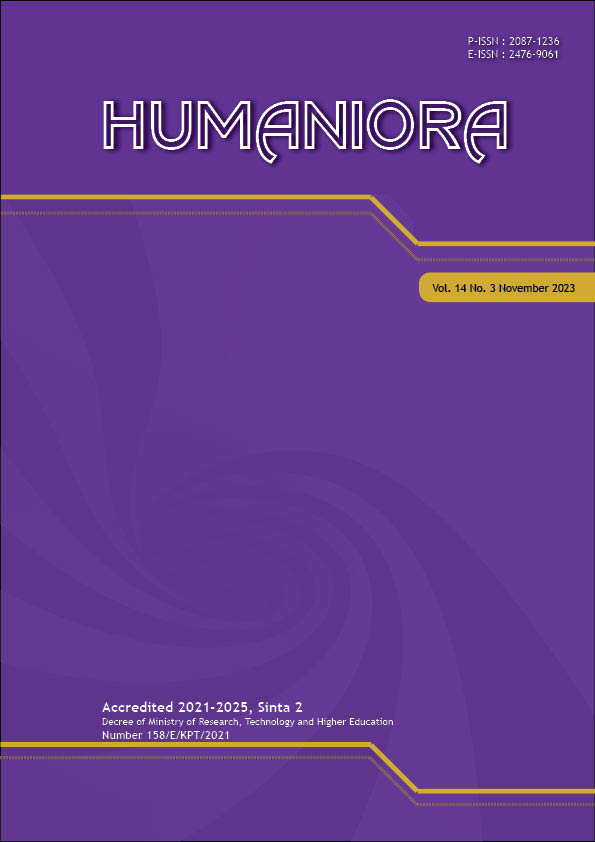“From the Series, I See that LGBTQ+ Characters are Ordinary Peopleâ€: An Audience Study on Netflix Series with LGBTQ+ Themes in 2020–2022
DOI:
https://doi.org/10.21512/humaniora.v14i3.10601Keywords:
audience study, gender study, LGBTQ , Netflix SeriesAbstract
The research focused on how the audience of gender-diverse series in Indonesia reacted to the LGBTQ+ themes broadcasted in some Netflix series aired from 2020 to 2022. It was interesting to discuss, considering that LGBTQ+ issues were still taboo, and that Indonesian society was known to be conventional and religious. By examining the audience’s reactions to the narration of LGBTQ+ themes, the research delved deeper into how Indonesian audience members problematize the LGBTQ+ issues in the Netflix series. The research was conducted with the qualitative research method by asking 70 participants, from whom validated informed consent was retrieved in advance, to answer the questions posed in the online questionnaire employed herein and by inviting them to join Zoom-mediated interviews. Three problematizations are found: Netflix’s ideology related to its LGBTQ+ content, audience perception about the LGBTQ+ community, and audience religiosity before and after watching such a series. There are also varying views on these problematizations according to the various manners in which audience members are reasoning, which are subsequently assigned to several clusters. Ultimately, such problematizations help shed light on how Netflix and its LGBTQ+ content is dynamically perceived by the audience.Â
Plum Analytics
References
Aditya, Y., Martoyo, I., Nurcahyo, F. A., Ariela, J., & Pramono, R. (2021). Factorial structure of the four basic dimensions of religiousness (4-BDRS) among Muslim and Christian college students in Indonesia. Cogent Psychology, 8(1), 1-17. https://doi.org/10.1080/23311908.2021.1974680.
Afifah, N., Daud, I., & Mulyadina, M. (2022). Viewer behavior on social media: Viral marketing of a movie trailer in Indonesia. Gadjah Mada International Journal of Business, 24(2), 178-197. https://doi.org/10.22146/gamaijb.49987.
Ahmed, W., Fenton, A., Hardey, M., & Das, R. (2022). Binge watching and the role of social media virality towards promoting Netflix’s Squid Game. IIM Kozhikode Society and Management Review, 11(2), 222-234. https://doi.org/10.1177/22779752221083351.
Amaki, Y. (2022). Promoting sexual and gender diversity through the portrayal of sexual and gender minority youths in media: The views of college students in Japan. Asian Review, 35(2), 23-48.
Ansow, D. F., Olii, S. T., & Kumayas, T. (2022). A study on students’ perception toward English learning at SMP Katolik St. Theresia Tanawangko. Journal of Teaching English, Linguistics, and Literature, 1(3), 375-385. https://doi.org/10.36582/jotell.v1i3.3757.
Boisvert, S. (2020). ‘Queering’ TV, one character at a time: How audiences respond to gender-diverse TV series on social media platforms. Critical Studies in Television, 15(2), 183-201. https://doi.org/10.1177/1749602020914479.
Changsong, W. (2019). Cinema attendance and cinema-going audience in Malaysia. Media Watch, 10(3), 539-549. https://doi.org/10.15655/mw/2019/v10i3/49682.
Chen, H., Ning, X., Wang, L., & Yang, J. (2018). Acquiring new factual information: Effect of prior knowledge. Frontiers in Psychology, 9, 1-14. https://doi.org/10.3389/fpsyg.2018.01734.
Cover, R. (2022). Making queer content visible: Approaches and assumptions of Australian film and television stakeholders working with LGBTQ+ content. Media International Australia, 190(1), 116-132. https://doi.org/10.1177/1329878X221077851.
Flores, A. R., Stotzer, R. L., Meyer, I. H., & Langton, L. L. (2022). Hate crimes against LGBT people: National crime victimization survey, 2017-2019. PLoS ONE, 17(12), e0279363. https://doi.org/10.1371/journal.pone.0279363.
Gabbiadini, A., Baldissarri, C., Valtorta, R. R., Durante, F., & Mari, S. (2021). Loneliness, escapism, and identification with media characters: An exploration of the psychological factors underlying binge-watching tendency. Frontiers in Psychology, 12, 785970. https://doi.org/10.3389/fpsyg.2021.785970.
Gamage, K. A. A., Dehideniya, D. M. S. C. P. K., & Ekanayake, S. Y. (2021). The role of personal values in learning approaches and student achievements. Behavioral Sciences, 11(7), 1-23. https://doi.org/10.3390/bs11070102.
GLAAD. (2023). Where we are on TV report 2022-2023. Retrieved from https://glaad.org/whereweareontv22/.
Guess, A. M., & Lyons, B. A. (2020). Misinformation, disinformation, and online propaganda. Cambridge: Cambridge University Press. https://doi.org/10.1017/9781108890960.
Güney, Ö. (2021). Discussing LGBTQ+ issues with Muslim students in the ESL classroom: The interface of culture, religion, and sexuality. In Paiz, J.M., Coda, J.E. (eds), Intersectional Perspectives on LGBTQ+ Issues in Modern Language Teaching and Learning (pp. 55-85). UK: Palgrave Macmillan, Cham.
Guskos, J., & Nordmann, E. (2023). Minorities in streaming services: The impact of LGBTQ+ character representation on viewers minorities in streaming services. Glasgow, UK: University of Glasgow.
Hall, A. (2020). Dear Netflix: You are propaganda. Retrieved from https://orphicmagazine.com/2020/07/10/dear-netflix-you-are-propaganda/.
Infortuna, C., Battaglia, F., Freedberg, D., Mento, C., Zoccali, R. A., Muscatello, M. R. A., & Bruno, A. (2021). The inner muses: How affective temperament traits, gender and age predict film genre preference. Personality and Individual Differences, 178, 110877. https://doi.org/10.1016/j.paid.2021.110877.
Kamalesh, V., Lakhotia, C., & Pandey, P. (2019). Influence of movie genre preference on empathy among emerging adults. The International Journal of Indian Psychology, 7(4), 34-41. https://doi.org/10.25215/0704.047.
Kapasi, A., & Pei, J. (2022). Mindset theory and school psychology. Canadian Journal of School Psychology, 37(1), 57-74. https://doi.org/10.1177/08295735211053961.
Khan, E. M., Mukta, M. S. H., Ali, M. E., & Mahmud, J. (2020). Predicting users’ movie preference and rating behavior from personality and values. ACM Transactions on Interactive Intelligent Systems, 10(3), 1-25. https://doi.org/10.1145/3338244.
Khoo, O. (2022). Picturing diversity: Netflix’s inclusion strategy and the Netflix recommender algorithm (NRA). Television & New Media, 24(3), 281-297. https://doi.org/https://doi.org/10.1177/15274764221102864.
Kubrak, T. (2020). Impact of films: Changes in young people’s attitudes after watching a movie. Behavioral Sciences, 10(5), 1-23. https://doi.org/10.3390/bs10050086.
Liao, C. H. (2023). Exploring the influence of public perception of mass media usage and attitudes towards mass media news on altruistic behavior. Behavioral Sciences, 13(8), 1-22. https://doi.org/10.3390/bs13080621.
Lin, Z., Yu, W. H., & Su, K. H. (2019). Comparing same- and different-sex relationship dynamics: Experiences of young adults in Taiwan. Demographic Research, 40, 431-462. https://doi.org/10.4054/DEMRES.2019.40.17.
Listiorini, D., Asteria, D., & Sarwono, B. (2019). Moral panics on lgbt issues: Evidence from Indonesian tv programme. Jurnal Studi Komunikasi (Indonesian Journal of Communications Studies), 3(3), 355-371. https://doi.org/10.25139/jsk.v3i3.1882.
Livingstone, S. (2013). The participation paradigm in audience research. Communication Review, 16(1-2), 21-30. https://doi.org/10.1080/10714421.2013.757174.
Mcdonald, S. M. (2012). Perception: A concept analysis. International Journal of Nursing Knowledge, 23(1), 2-9. https://doi.org/10.1111/j.2047-3095.2011.01198.x.
Mills-Koonce, W. R., Rehder, P. D., & McCurdy, A. L. (2018). The significance of parenting and parent–child relationships for sexual and gender minority adolescents. Journal of Research on Adolescence, 28(3), 637-649. https://doi.org/10.1111/jora.12404.
Mokhtar, M. F., Sukeri, W. A. E. D. W., & Latiff, Z. A. (2020). Social media roles in spreading LGBT movements in Malaysia. Asian Journal of Media and Communication, 3(2), 77-82. https://doi.org/10.20885/asjmc.vol3.iss2.art4.
Naqvi, M. H., Jiang, Y., Miao, M., & Naqvi, M. H. (2020). The effect of social influence, trust, and entertainment value on social media use: Evidence from Pakistan. Cogent Business and Management, 7(1), 1723825. https://doi.org/10.1080/23311975.2020.1723825.
Nisa, H., Hidayat, R., & Samiun, B. (2023). Relevance of ethical norms and religious values to realize a harmonious and dynamic social life. Pancasila International Journal of Applied Social Science, 1(1), 61-67. https://doi.org/10.59653/pancasila.v1i01.84.
Novis-Deutsch, N., Keysar, A., Beit-Hallahmi, B., Sztajer, S., Klingenberg, M., & Piltzecker, T. (2022). Conservative and liberal values in relation to religiosity. In The Diversity of Worldviews Among Young Adults. https://doi.org/10.1007/978-3-030-94691-3.
Pfeifer, J. H., & Berkman, E. T. (2018). The development of self and identity in adolescence: Neural evidence and implications for a value-based choice perspective on motivated behavior. Child Development Perspectives, 12(3), 158-164. https://doi.org/10.1111/cdep.12279.
Putri, A. E., Syam, H., Nazhifah, N., Azizah, N., & Andesfi, R. (2023). Case studies of the rise of lesbian, gay, bisexual, and transgender (LGBT) in Indonesian Society. Journal of Education Technology, 1(1), 48-55. https://doi.org/10.58578/alsystech.v1i1.1362.
Ramdas, K. (2021). Negotiating LGBTQ rights in Singapore: The margin as a place of refusal. Urban Studies, 58(7), 1448-1462. https://doi.org/10.1177/0042098020962936.
Riadil, I. G. (2020). Lgbtq+ existence in Indonesia: Investigating Indonesian youth’s perspectives towards the lgbtq+ community. Berumpun: International Journal of Social, Politics, and Humanities, 3(2), 166-181. https://doi.org/10.33019/berumpun.v3i2.30.
Ridwan, R., & Wu, J. (2018). ‘Being young and LGBT, what could be worse?’ Analysis of youth LGBT activism in Indonesia: Challenges and ways forward. Gender and Development, 26(1), 121-138. https://doi.org/10.1080/13552074.2018.1429103.
Sullivan, N. (2003). A critical introduction to queer theory. Edinburgh, UK: Edinburgh University Press. https://doi.org/10.1515/9781474472944.
Syam, H. M., Anisah, N., Saleh, R., & Lingga, M. A. (2021). Ideology and media framing: Stigmatisation of LGBT in media coverage in Indonesia. Jurnal Komunikasi: Malaysian Journal of Communication, 37(1), 59-73. https://doi.org/10.17576/JKMJC-2021-3701-04.
Tankard, M. E., & Paluck, E. L. (2016). Norm perception as a vehicle for social change. Social Issues and Policy Review, 10(1), 181-211. https://doi.org/10.1111/sipr.12022.
Taylor, J. (2013). Hume on the importance of humanity. Revue Internationale de Philosophie, 263(1), 81-97. https://doi.org/10.3917/rip.263.0081.
Thomson, K. (2021). An analysis of LGBTQ+ representation in television and film. Bridges: An Undergraduate Journal of Contemporary Connections, 5(1), 1-9.
Usman, M., Li, C., Chaudhry, N., & Akhter, W. (2023). Does religion impact corporate innovation in developing countries? Journal of Islamic Accounting and Business Research, 14(6), 887-910. https://doi.org/10.1108/JIABR-10-2022-0258.
Verkuyten, M., & Killen, M. (2021). Tolerance, dissenting beliefs, and cultural diversity. Child Development Perspectives, 15(1), 51-56. https://doi.org/10.1111/cdep.12399.
Watini, S. (2020). Implementation of asyik play model in enhancing character value of early childhood. Journal of Physics: Conference Series, 1477(4), 042055. https://doi.org/10.1088/1742-6596/1477/4/042055.
Wessels, B. (2023). How audiences form: Theorising audiences through how they develop relationships with film. Participations, 19(2), 285-303.
Wilkinson, C., Paula, G., Baden, O., & Antony J., L. (2017). LGBT rights in Southeast Asia: One step forward, two steps back? IAFOR Journal of Asian Studies, 3(1), 5-17. https://doi.org/10.22492/ijas.3.1.01.
Wijaya, H. Y. (2020). Public discourses about homosexuality and religion in Europe and beyond. In Public Discourses About Homosexuality and Religion in Europe and Beyond. Switzerland: Springer International Publishing. https://doi.org/10.1007/978-3-030-56326-4.
Yu, A., & Lam, S. K. N. (2023). Decriminalising homosexuality in Singapore: Political responses from the perspective of secularism and electoral pragmatism. Round Table, 112(2), 163-172. https://doi.org/10.1080/00358533.2023.2202948.
Yunior, D. S. (2023). Media ideology and representation of the national police image in the online media frame (Framing analysis of Teddy Minahasa drug case in the October 15, 2022 edition of Koran Tempo online). International Journal of Social Service and Research, 3(8), 1925-1938. https://doi.org/10.46799/ijssr.v3i8.474.
Zed, R. (2015). Faith forum: Does watching movies affect one’s faith? Retrieved from https://www.rgj.com/story/opinion/columnists/2015/12/09/faith-forum-does-watching-movies-affect-ones-faith/77054604/.
Żerebecki, B. G., Opree, S. J., Hofhuis, J., & Janssen, S. (2021). Can TV shows promote acceptance of sexual and ethnic minorities? A literature review of television effects on diversity attitudes. Sociology Compass, 15(8), 1-16. https://doi.org/10.1111/soc4.12906.
Zhao, Y., Shi, J., Liu, J., Zhao, J., Zhou, F., Zhang, W., Chen, K., Zhao, X., Zhu, C., & Chen, W. (2022). Evaluating effects of background stories on graph perception. IEEE Transactions on Visualization and Computer Graphics, 28(12), 4839-4854. https://doi.org/10.1109/TVCG.2021.3107297.
Zhu, L., & Wu, Y. (2021). Love your country: EEG evidence of actor preferences of audiences in patriotic movies. Frontiers in Psychology, 12, 1-12. https://doi.org/10.3389/fpsyg.2021.717025.
Downloads
Published
How to Cite
Issue
Section
License
Copyright (c) 2023 Ririn Kurnia Trisnawati, Tribuana Sari, Indriyati Hadiningrum

This work is licensed under a Creative Commons Attribution-ShareAlike 4.0 International License.
Authors who publish with this journal agree to the following terms:
a. Authors retain copyright and grant the journal right of first publication with the work simultaneously licensed under a Creative Commons Attribution License - Share Alike that allows others to share the work with an acknowledgment of the work's authorship and initial publication in this journal.
b. Authors are able to enter into separate, additional contractual arrangements for the non-exclusive distribution of the journal's published version of the work (e.g., post it to an institutional repository or publish it in a book), with an acknowledgment of its initial publication in this journal.
c. Authors are permitted and encouraged to post their work online (e.g., in institutional repositories or on their website) prior to and during the submission process, as it can lead to productive exchanges, as well as earlier and greater citation of published work.
USER RIGHTS
All articles published Open Access will be immediately and permanently free for everyone to read and download. We are continuously working with our author communities to select the best choice of license options, currently being defined for this journal as follows: Creative Commons Attribution-Share Alike (CC BY-SA)
























